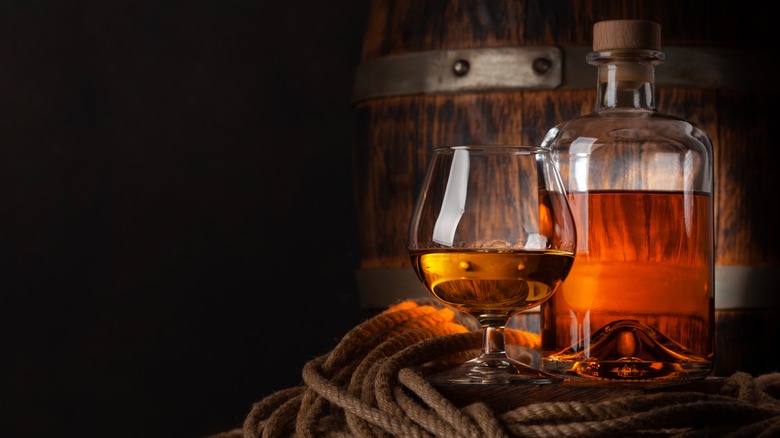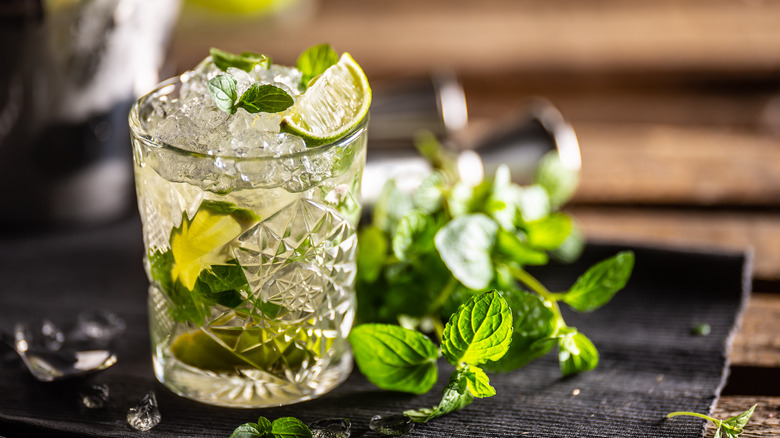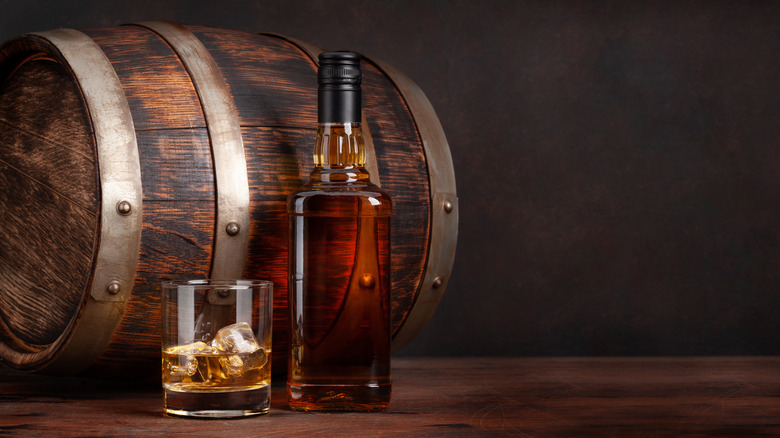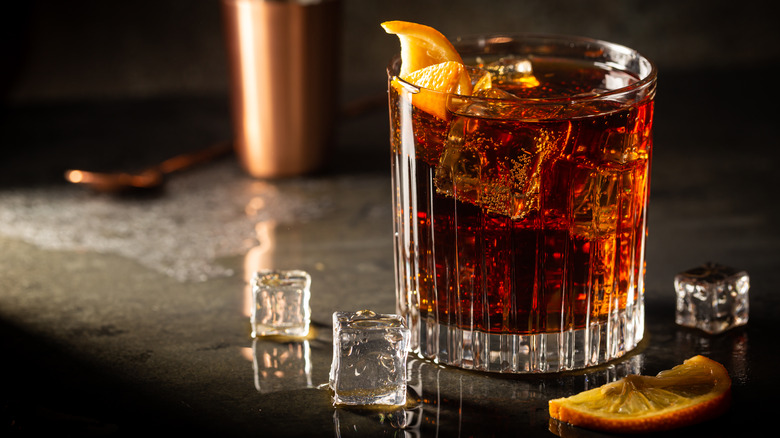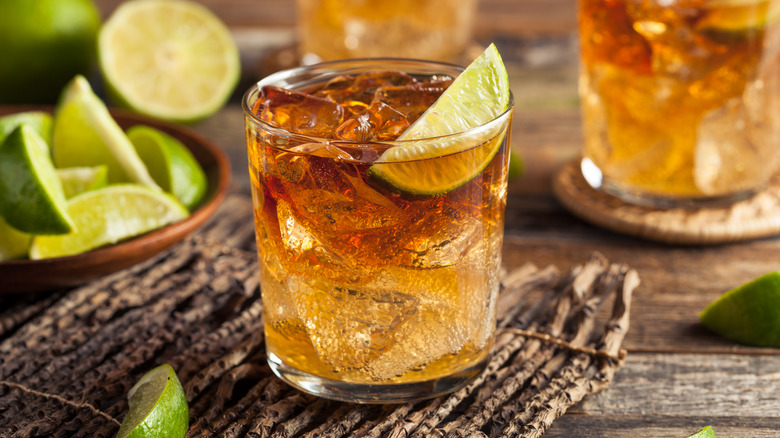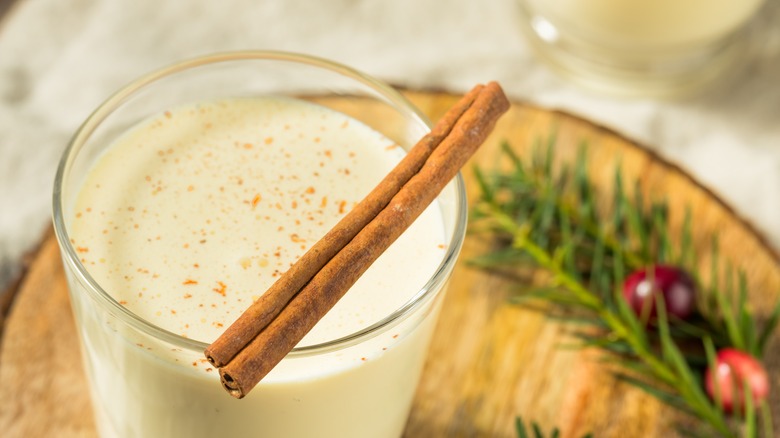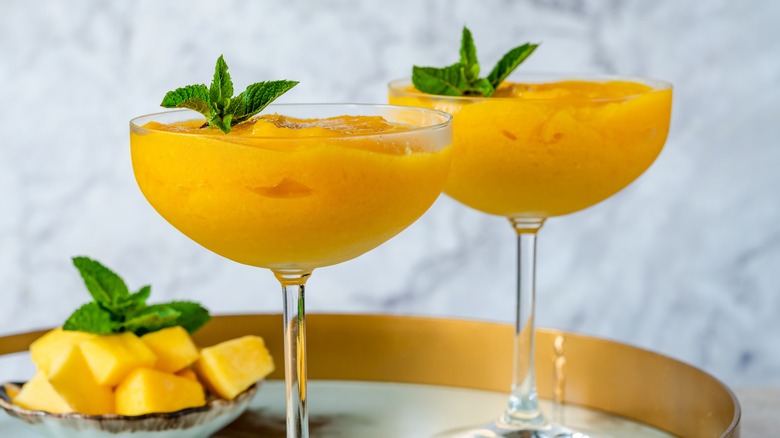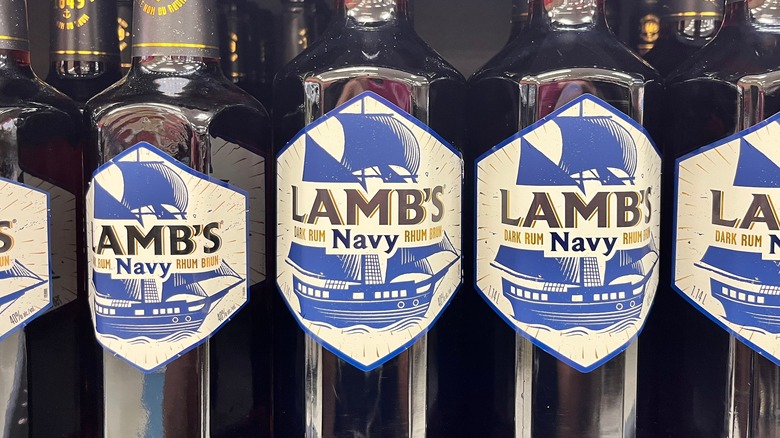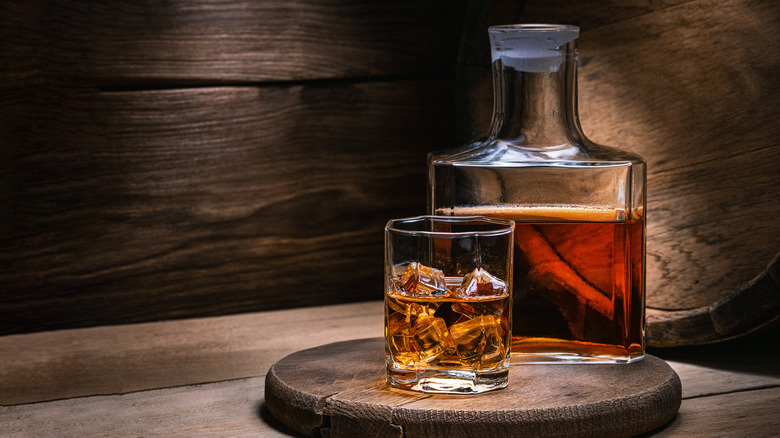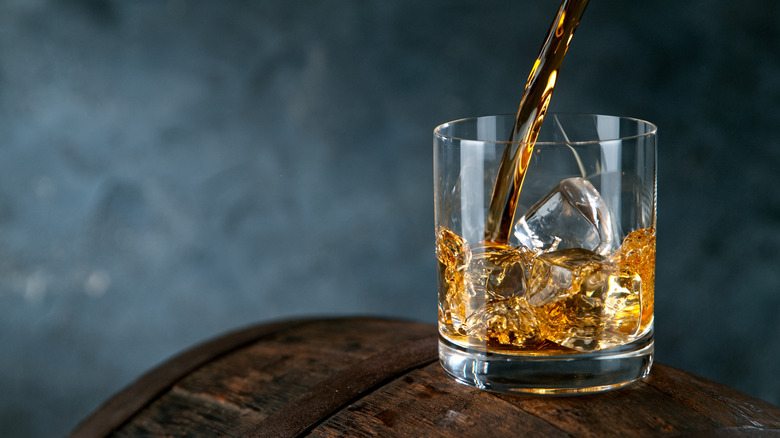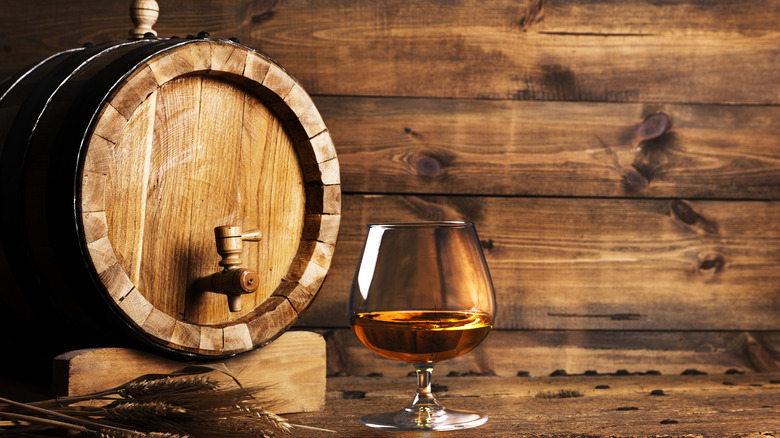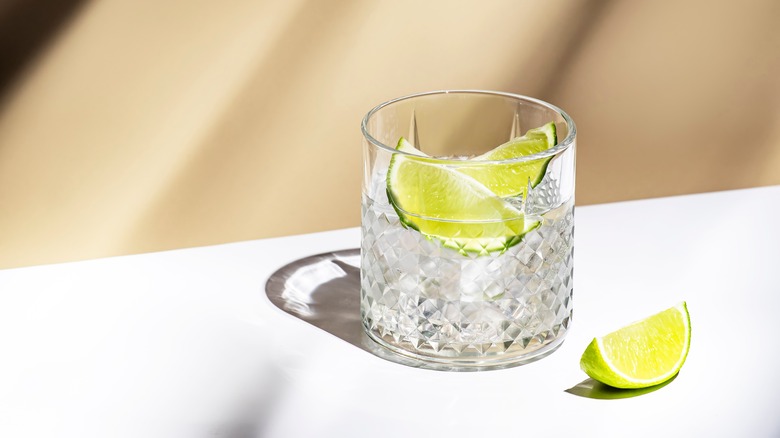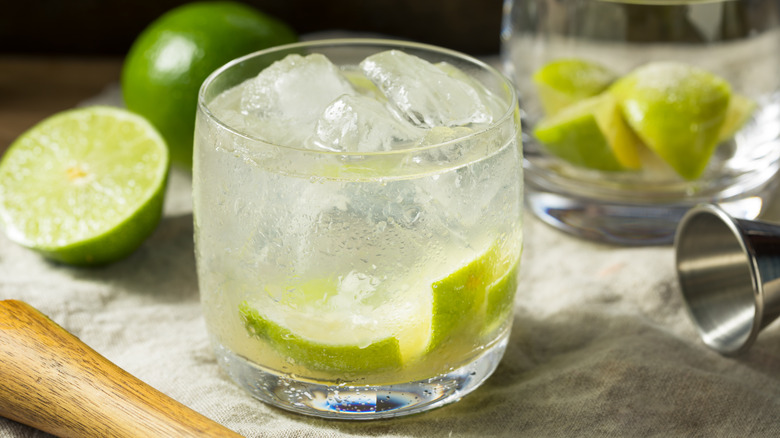14 Types Of Rum And What To Mix Them With
From its Caribbean origins to its status as a global favorite, rum has evolved over centuries to encapsulate a wide range of styles, each with its own unique characteristics and charm. To the newcomer, the sheer variety of rums out there can be a little daunting but fortunately, all it takes is a little knowledge to understand how rum is made and how the styles differ. Armed with this information, you'll be able to identify which rums match your personal preference, and how to make the most out of every type.
Before we start exploring the numerous forms rum can take, let's start with the basics. Rum is a liquor that's created by fermenting the byproducts of sugarcane — most commonly molasses, but occasionally the sugarcane juices. As a result, rums are known for their sweet characteristics; however, they're generally not sickly or insipid, as much of the sweetness is lost during the distillation process, making room for more subtle flavors such as vanilla, spice, and tobacco. Ultimately, the complete flavor profile of a rum comes down to the particular style.
White rum
Also known as silver rum or light rum, this variant is best known for its versatility, along with its smooth, mild flavor. White rum's subtle taste is a result of a shorter aging process, usually not longer than three to twelve months, meaning it doesn't pick up as many standout characteristics from the barrel.
The other thing that sets white rum apart from other styles is its complete lack of color. While it's true that rums that aren't aged as long will be lighter, the total clarity of white rum comes from post-distillation filtration that removes all color. Filtering the rum eliminates the color and impurities without removing the flavors, while also creating a smooth product despite not undergoing an extensive aging process.
When it comes to mixing white rum, the world is your oyster. It has a clean, refreshing character, and the lack of dominating flavors means it works well with most mixers as it's not competing for your taste buds' attention. Think of it as a blank canvas — you can use it in cocktails like mojitos to highlight citrus components that would otherwise be overpowered, up the intensity with a fiery ginger beer, or use it as a base for classic Tiki-style drinks. However, it's always fun to get experimental, and white rum also works great as a base for trying out infusions.
Golden rum
Golden rum, sometimes referred to as amber rum due to the distinct coloration it takes on from the aging process, has a much more complex flavor profile than its clear cousin. These styles of rum are aged longer, usually for around two years, and are unfiltered, so they retain all of the color and flavor imparted by the barrel.
Now, the tasting notes of golden rum can vary depending on the length of the aging process, and the barrel itself. The longer the rum is aged, the smoother it will be, and the more intense the flavors will be. Golden rum is most associated with caramel and vanilla flavors; however, sometimes the rum is aged in barrels that have already been used to mellow other liquids like whiskey, sherry, or wine, imparting some of their characteristics into the final product.
High-quality golden rum can be enjoyed in the same manner as whiskey if it's smooth enough, either neat or with a few ice cubes, but it also works really well as a substitute for white rum in cocktails if you want to boost their sweetness and complexity. Our favorite use is actually as a vodka replacement in an espresso martini as it rounds out some of the bitterness from the coffee and adds a toffee-like quality.
Dark rum
The longer spirits are aged in barrels, the darker they become, therefore dark rum is what we call rum that has been aged until it has taken on a deep, mahogany hue. The length of the aging process can vary, and typically there isn't an upper limit.
This longer aging process produces richer, deeper flavors in the rum, such as oak and leather, and the caramel notes develop into toffee or even pure molasses. Like golden rum, dark rum makes for a great sipping drink thanks to its increased complexity and is often paired with lighter rums in tiki cocktails like the mai tai, or dessert-inspired cocktails like the Rum Alexander.
However, you can really make the most of dark rum's flavor profile by using it as a replacement liquor in spirit-forward cocktails, like an Old Fashioned. Diluting the rum this way reduces the heat from the alcohol and opens up the aromas, and you can experiment with different types of bitters — like orange or chocolate — to balance out the flavors that are already present.
Black rum
Black rums are the most aged of the rum family, with the aging process resulting in a spirit that's almost completely black, hence the name. The flavor intensity and complexity are dialed up to eleven, with a bolder expression of molasses and potentially even notes of chocolate or coffee.
While you can certainly make great use of black rum in cocktails and with mixers, it's important to tread carefully, as it can really overpower less-dominant ingredients, making them somewhat redundant. Go for distinct ingredients that you'd typically pair with the bold flavors from the rum, such as cherry, vanilla, or even banana.
Arguably the most famous of the dark rum cocktails is the Dark 'N' Stormy – a blend of dark rum and spicy ginger beer or ginger ale, with wedges of lime to cut through the intense flavors, and a couple of dashes of Angostura bitters to balance out the ingredients and bind them together. It's bold yet refreshing and can serve as a great inspirational template for further experimentation.
Spiced rum
Spiced rum is one of the more modern additions to the rum family, introduced to mass markets by the Captain Morgan Rum company in the 1980s, and it's become a staple behind most bars in the decades since. Simply put, the style is a golden or dark rum that's been infused with a blend of spices, such as cinnamon, vanilla, star anise, clove, ginger, nutmeg, and citrus.
Given what we've covered so far, you can see how these particular spices match up with the flavor profile or darker rums, and the result is a spirit with a warm, inviting aroma and a sweet yet savory taste. Spiced rum is versatile, and while it's most commonly mixed with cola, it's worth exploring those warming qualities.
Most of the spices used in spiced rum are associated with the festive season, so it works perfectly in fortified winter drinks, like homemade eggnog or hot buttered rum. It also makes a great substitute for regular rum in classic Tiki drinks, adding more depth and flavor to complex cocktails in a way that doesn't interfere with the other ingredients.
Flavored rum
Unlike spiced rum, which focuses primarily on a mix of spices, flavored rum can be infused with a wide range of natural or artificial flavors. Traditionally, the most common flavored rum you'd find behind a bar would probably be of the coconut variety, like Malibu, because it made for an easy addition to tropical cocktails and was light enough that it worked with most mixers.
Nowadays, with rum sales soaring, there are dozens of flavored rums on the market, with fruity variants like pineapple, passion fruit, and mango, or more dessert-like rums, such as chocolate, caramel, or vanilla. These flavors all bring a new dimension to the rum's character and are a great way to put specific twists on your cocktails.
However, be aware that the quality of flavored rums can vary, and their flavor profiles may change based on the quality of the base rum. Also, given that rum is already a sweeter spirit, it's possible to use too much of a flavored rum with insipid results.
Navy-strength rum
Rum has long been associated with sailors, ships, and the sea, and the spirit has a storied history in the maritime world, particularly the British Royal Navy. After the British invaded Jamaica in the 17th century, the Navy began giving its officers a daily ration of Jamaican rum, a high-strength variety bottled at between 54% and 57% ABV.
In fact, the term "proof" that we used to describe the strength of a spirit actually dates back to this time. Officers would test the strength of their rum by mixing it with gunpowder, and if the rum could be set alight, it was considered proof of its strength.
Navy-strength rum — or Navy rum — is the name given to high-strength dark rum with the same ABV that was issued centuries ago. Its age and strength give Navy rum an intense flavor of molasses, oak, and spices, and many traditionalists like to sip it neat, despite its higher alcohol content. However, it's also finding its place in the cocktail world, used sparingly to add depth to robust cocktails that can handle its bold presence.
Overproof rum
Interestingly, overproof rum's name also comes from a time when it was commonplace for sailors to set fire to liquor to ensure it was strong enough for their tastes. If the spirit burned steadily, that was proof, but if it went off with a bang, it was considered "overproof."
Nowadays, overproof is the label given to rums that are over 57% ABV but many can reach as high as 75.5% ABV. As you've probably gathered, it doesn't make a suitable one-to-one replacement for regular-strength rum. So, what is it used for?
Aside from being used sparingly to add depth to certain cocktails, like the infamous Zombie, overproof rum is also used for flaming cocktails which, as long as you don't bring gunpowder to the mix, shouldn't go off with a bang. It can also be used as a cooking ingredient in things like desserts and sauces. It's a little more subdued than spiced rum, and some of the alcohol will burn off during cooking, so the high strength won't negatively impact your food.
Single-vintage rum
Single vintage rums are the rarest and most highly sought-after of the rums on this list and come with a price tag to match. Having said that, these rums are genuinely some of the finest in the world and deserve their reputation, if not their cost.
These are rums that have been aged and bottled from a single year's distillation because, much like wine, some years are simply better than others when it comes to the quality of the organic base ingredients. These rums are usually aged for longer periods of time to boost their flavor, complexity, and smoothness, and while they taste phenomenal, many who collect them see them as a piece of history.
Having said that, we believe that rum is made to be drunk, so if you are lucky enough to find yourself in possession of a bottle of vintage rum, go ahead and open it up. That said, many would consider mixing such a rum with soda an unforgivable crime, and that it should be sipped like you would a rare whiskey. If you want to experiment a little with your palate, try enjoying a glass with a wedge of orange and a square of rich, dark chocolate.
English rum
We've touched on the fact that the English and rum have an interwoven history dating back to the colonial era. Thanks to their control of sugar production in tropical lands, they were able to bring the ingredients back and start producing rum in Great Britain.
Unlike many other rum-producing countries, there aren't many strict criteria that English rum has to meet to be considered an English rum. As a result, the range of English rums is extremely diverse and includes all of the varieties we've mentioned so far and one that we're getting to. These English-style rums, therefore, are usually full-bodied and often distilled in a pot-still. But, with rum on an upward trend right now, there's also been somewhat of a renaissance of craft distilleries popping up around England, so you can expect the range to grow.
The style of English rum you choose will dictate how you should use it — embrace the versatility of lighter rums and expose the deep flavors of the darker ones.
Spanish rum
Spanish rums tend to be a little softer, sweeter, and more approachable than others for a few reasons. First, the rum is normally distilled in column stills which makes the end product a little more neutral, so it takes more characteristics from the barrel. This gives it a complex spice and boosts the vanilla and caramel elements. Then, the rum is charcoal filtered which makes it even smoother.
Some Spanish rums also use a different aging method than others, a process the country pioneered and which has since been adopted by other spirit distillers, called the solera aging method. Instead of fully emptying a barrel when the rum is ready, only around half of the contents are removed before a new rum is added. By aging the rum this way, the average age of the rum being produced increases over time, meaning you're more likely to get a rum of consistently high quality.
The smoothness of Spanish rums makes them ideal for sipping, especially for those getting used to enjoying their spirits neat, and their pronounced barrel qualities make them ideal for complex tropical cocktails like pina coladas.
Rhum Agricole
Rhum Agricole is the name given to French-style rums — or rhums — which have one key difference from the rest of the styles we've covered so far. Like English rum, French rhum comes from the country's colonial Caribbean interests, but rather than being made from molasses, it's made from fresh sugarcane juice.
Understandably, this has a profound impact on the taste of the rhum, so while it still has a sweetness to it, it tends to have an earthier and more vegetal flavor. It has a fruity nose reminiscent of pineapple, mango, and banana, a drier mouthfeel, and comes in both light and dark varieties. In true French style, Cognac and Armagnac barrels are often used to age darker rhums.
Rhum Agricole can be a unique yet potent ingredient to have on your bar shelf thanks to its distinct characteristics. For example, the lighter rhums can be used as a white rum replacement to add a grassy and herbal dimension to cocktails, whereas the darker styles can be used to do the same for whiskey-based drinks and shine when amplified with flavor-boosting bitters.
Cachaça
Cachaça is the national spirit of Brazil, which explains why its production is so tightly controlled. Thanks to its cultural significance, it must undergo specific production methods, and can only be made in Brazil, otherwise it isn't considered authentic.
In terms of style, cachaça is similar to Rhum Agricole as it's also made from fresh sugarcane juice rather than molasses, so the flavor profiles are very similar. However, unlike Rhum Agricole, cachaça must be made using copper pot stills that contribute to its robust and aromatic character while retaining more of the flavor from the sugarcane. There are two varieties of the rum, unaged white cachaça or aged golden cachaça, with the latter considered the more premium.
While aged cachaça is usually drunk neat or with a little ice due to its richer profile, white cachaça has found a place in dozens of refreshing yet bold cocktails. The most famous of these is the must-try Caipirinha, a simple, thirst-quenching concoction of cachaça, sugar, lime, and ice, that's perfect on a summer's day.
Alcohol-free rum
With alcohol-free beverages becoming more and more popular, it appears that non-alcoholic beer and wine receive most of the attention; however, there have been some intriguing developments in the AF spirit world, not least with rum. Nowadays, it's possible to find alcohol-free rums of almost every type, including white, golden, dark, and spiced.
There are a few different production methods for alcohol-free rum, and each of them are relatively effective in creating a beverage that mimics the real thing; however, some are better than others at creating an authentic-tasting product. Some "distillers" recreate the flavors of rum simply by blending natural extracts, botanicals, and flavorings, whereas other producers go through a genuine distilling process using yeast strains that produce very low levels of alcohol. Some distillers may even make a full-strength rum before removing the alcohol via further distillation, in a way that retains the desired flavor and mouthfeel.
Alcohol-free rum comes in a range of traditional styles, so you can use them in the same way you would use full-strength versions; although, the strength of their flavor can vary depending on the production method, and you may need to adjust your ingredients accordingly.

